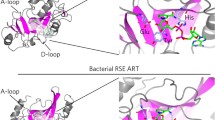Abstract.
Poly(ADP-ribosyl)ation is a posttranslational modification of proteins in eukaryotic cells catalysed by a family of NAD+ ADP-ribosyl transferases, the poly(ADP-ribose) polymerases (PARPs). PARP-encoding genes now constitute a superfamily of at least 18 members encoding proteins that share homology with the catalytic domain of the founding member, PARP-1 [1]. Poly(ADP-ribose) metabolism is of central importance in a wide variety of biological processes including maintenance of genomic stability [2–4], DNA repair [3, 5], transcriptional regulation [6, 7], centromere function [8, 9], modulation of telomere length [10–12], regulation of proteasomal protein degradation [13, 14], regulation of endosomal vesicle trafficking [15, 16] and apoptosis [17, 18]. The life cycle of poly(ADP-ribose) is discussed in the following section. In addition, an overview of the genes and proteins involved in poly(ADP-ribose) metabolism and their possible cellular function is provided.
Similar content being viewed by others
Author information
Authors and Affiliations
Corresponding author
Rights and permissions
About this article
Cite this article
Diefenbach, J., Bürkle, A. Poly-ADP-ribosylation in health and disease. CMLS, Cell. Mol. Life Sci. 62, 721–730 (2005). https://doi.org/10.1007/s00018-004-4503-3
Issue Date:
DOI: https://doi.org/10.1007/s00018-004-4503-3



